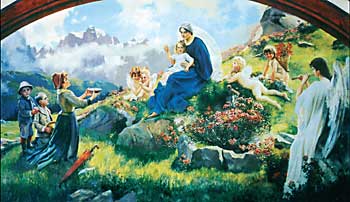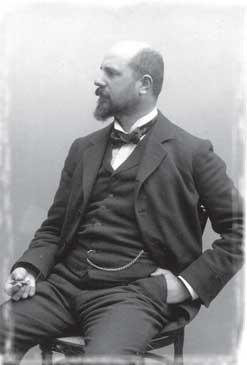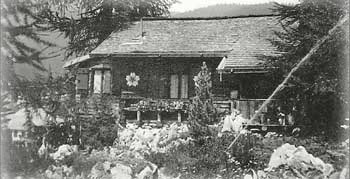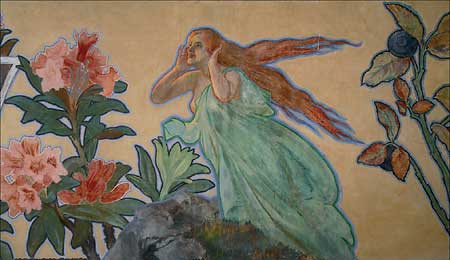|
Art and tourism during the Belle
Époque

La Madonna di Campiglio, 1897

G. Hofer’s portrait

Hoffer’s House in Madonna
di Campiglio |
|
BETWEEN XIX AND XX CENTURY
Palaces and mountain huts for Gottfried Hofer
exhibition in Campiglio
by Giovanna Recusani
editor of the exhibition
The fortunes of Madonna di Campiglio owe a lot to Gottfried
Hofer, versatile and enterprising artist who intertwined his
personal life, with the one of the nobles of his time. This
plot, among art, worldliness, and love for the mountains,
tries to illustrate the exhibition that Madonna di Campiglio
is hosting between July and August, and that is dedicated to
the canvas, frescos and photographs by the Central European
artist.
On this occasion, the Salone Hofer (Hofer Hall), attached to
the Des Alpes Hotel, opens the doors to the visitors who can
admire the frescoes picturing the famous faces of the Habsburg,
including Pincess Sissi, framed by flower decorations, typical
of that time.
The brightness of the colours, perfectly preserved, was obtained
by a mixture of tempera and casein and by the effect of the
sorrounding colour, that contrasts with the decorations at the
back.
The exhibition takes place in many different spots like the
Capanna Hofer (Hofer Hut) on Mount Spinale, near the cableway
arrival, and the Palazzo dei Congressi di Campiglio (Campiglio
Congress Hall).
The Capanna Hofer will again be for a short length of time,
the high mountain artist’s atelier where, next to the
easel and his work tools, we can see a documentary on his life
and works. At Palazzo dei Congressi there are many unseen works,
among drawings, sketches, pictures, studio and documentation
photographs, found both in Val Rendena and abroad, in private
collections and museums.
Born in Bolzano in 1858, Hofer lived between Paris and Rome,
Bremen and Berlin; in Madonna di Campiglio he spent many summers
and it is here where he wrote some of the most beautiful pages
of his artistic life that this exhibition allows us to get to
know for the first time in a deep and very articulated way.
His love for Campiglio led him to accept the assignment to become
President of the “Società dell’Abbellimento”,
a sort of forerunner Tourism Office, beside leaving an extraordinary
iconographic documentation on nature in the Dolomites and in
Val Rendena.
The exhibition section held at Palazzo dei Congressi is exactly
on the history of tourism development, which had started from
him, as a social, economic and cultural phenomenon, seen through
the building of great hotels and the local image spread throughout
Europe with the first printed guides. The retrospective eye
of the event lingers on the transformation of Campiglio from
a medioeval pilgrim hospice into a high standard touristic resort,
thanks to pioneers such as Giambattista Righi, the Oesterreichers,
the Neumanns and the Ferrazzas.
Educated as an academic painter in Munich, between 1876 and
1883, Hofer walked along the compulsory stages for all artists
of his time: Pompei, Capri, Venice and Rome.
He received a bronze medal at the Universal Exhibition af Arts
in Paris in 1889 thanks to a landscape work named “Pescatori
nella Laguna” (Fishers in the Lagoon), today at the Ferdinandeum
in Innsbruck.
He got close to issues and expression- tecniques of a group
of artists called the German-Romans, i.e. Fuerbach, Hildebrand,
Marees and above all, Boecklin. The impressionist influences
absorbed during his stay in Paris, reveal themselves mainly
in the landscapes, while in the official portraits Hofer keeps
his initial academic inprinting.
In Campiglio, the artist reconciled his technical and academic
nature with the joy of his “Jugendstil” ( a German
artistic movement to which he got close for a while).
This creative enterprise can be observed in the canvas but,
above all, on the walls of the dining room of the Grand Hotel
Des Alpes, which is a pictorial cycle in which the artist expressed
at best his talent: the characters of nobility are blended in
on the walls with the mythological quotations and representations
of the sorrounding alpine nature. Here the painter recalls,
among other things, the world of the Greek gods: here we have
the nimph Echo between a bilberry and a rhododendron.
For this artistic qualities and the historical documentation
the hall Des Alpes has been recently declared by the “Sovrintendenza
ai Beni Artistici e Culturali”, “cultural heritage
of peculiar importance”: the property allows the access
to the public only during the exhibition, a rare and appreciable
occasion indeed.
|




